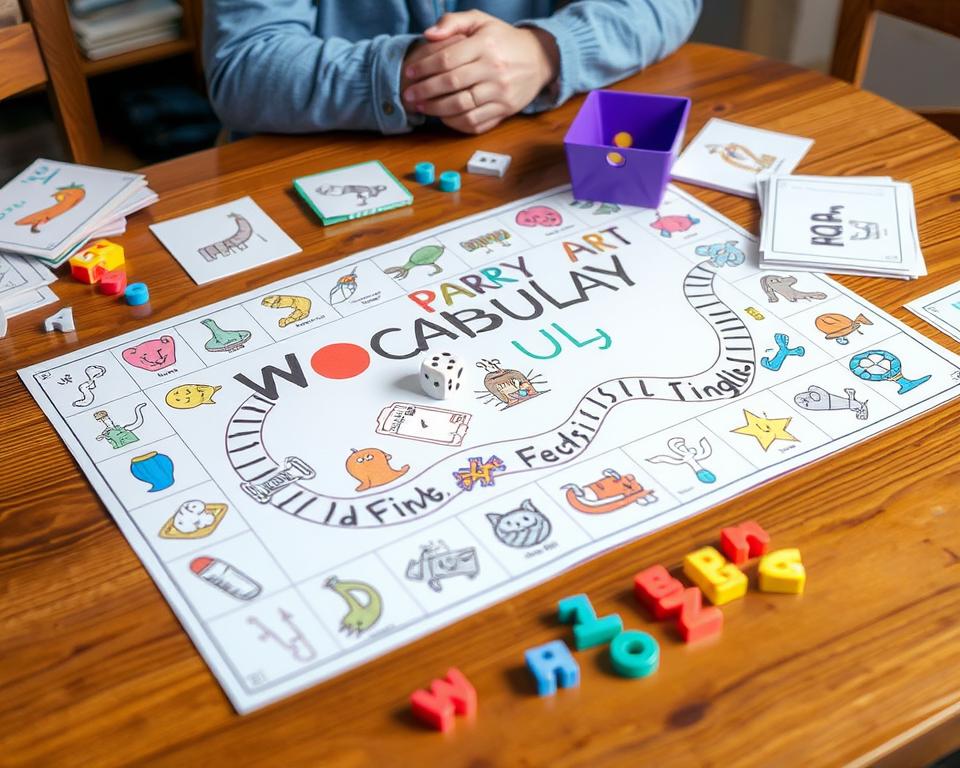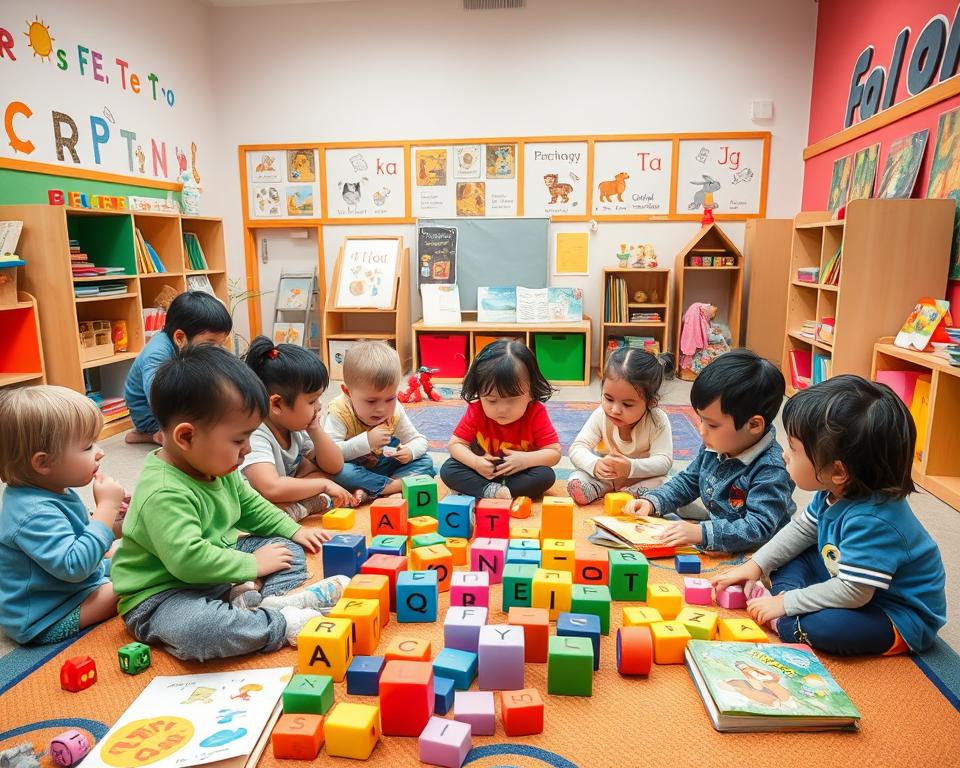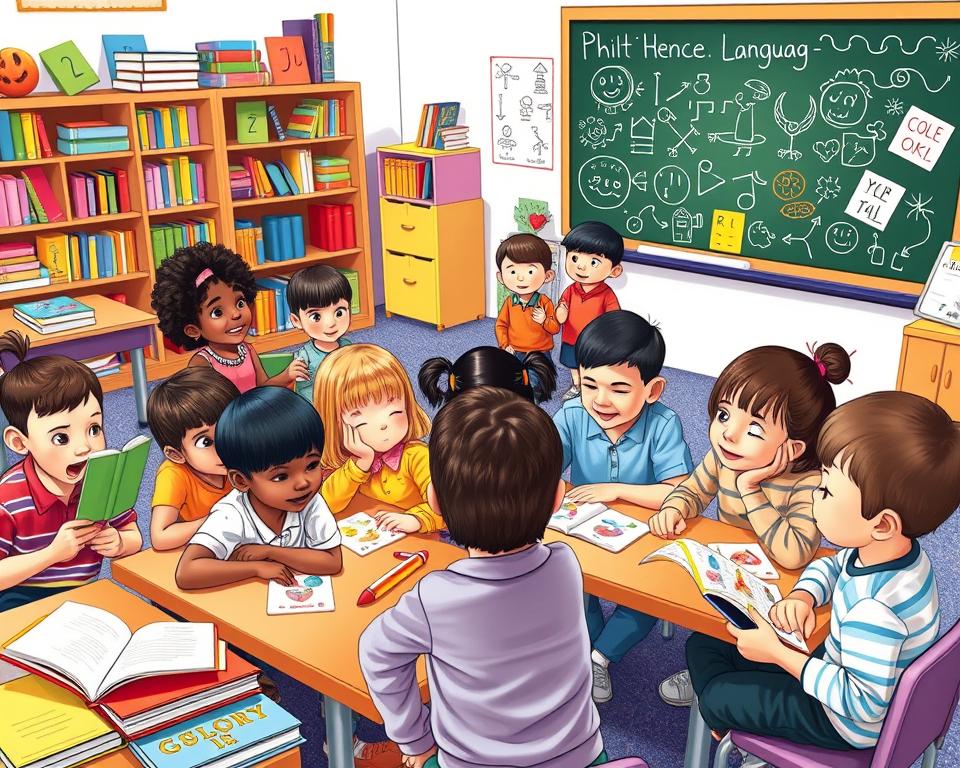Did you know homemade board games can really help with learning new words? Studies show that kids who play these games remember 20% more words than those in regular classes. This makes easy DIY board games for vocabulary practice a great tool for teachers and parents to help kids learn more.
In this article, we’ll look at how DIY games can help with vocabulary. We’ll also cover what you need to make them and how to create your first game board. These games are perfect for teachers wanting to make learning fun or parents looking for educational fun activities.
Understanding the Power of DIY Vocabulary Games
DIY vocabulary games are great for learning because they mix fun with practice. You can make games that help with skills like decoding and encoding words. They also help with sight words and expanding your vocabulary.
These games are special because they meet each person’s learning needs. You can make games that match what each student needs to learn. This way, everyone gets to learn at their own pace.
Also, you can make games about different topics and levels. You can use stories or themes that students find interesting. This makes learning fun and keeps it exciting for everyone.
“DIY vocabulary games are a game-changer in the classroom. They transform language learning into an immersive and enjoyable experience for students.” – [Expert Educator]
DIY vocabulary games help you remember words better. They make learning fun and add the practice needed to remember words. This makes learning stick in your mind.
Creating games like word-matching or board games can really help students. It makes them excited about learning languages. With a bit of creativity, you can make learning fun and effective.
- DIY vocabulary games are effective tools for learning because they combine fun with repetitive practice.
- They can be customized to focus on specific skills such as decoding words, encoding words, sight words, and vocabulary practice.
- These games allow for differentiation based on individual learning needs and can be adapted to suit various themes and difficulty levels.
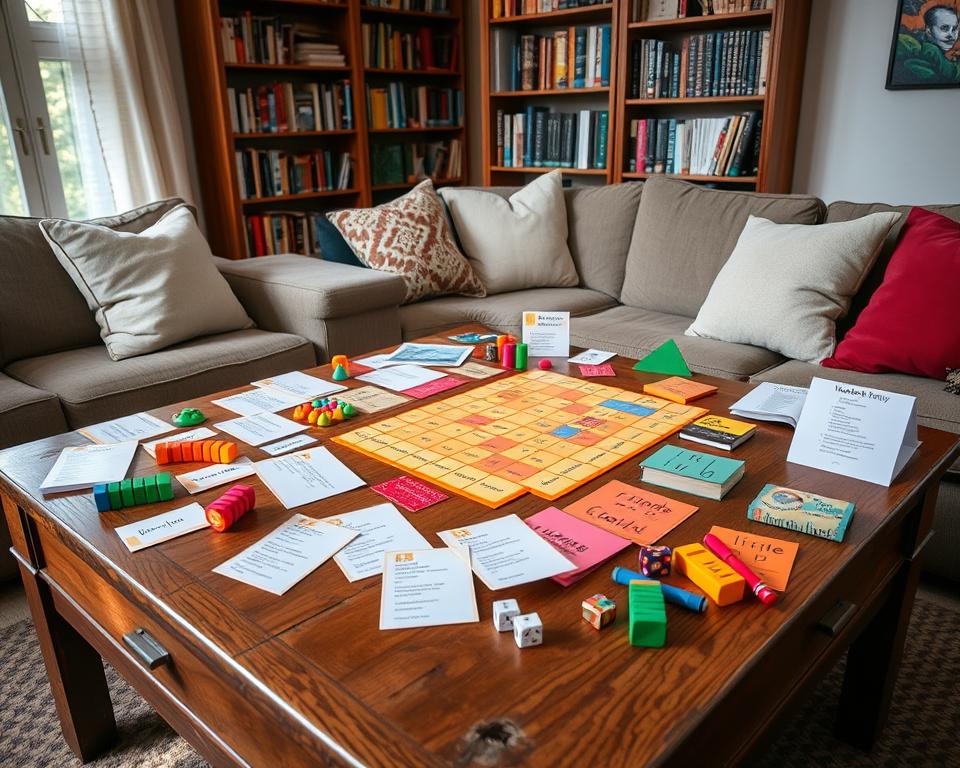
Board games are an engaging and interactive way to make vocabulary practice fun and effective for young learners. Creating your own board games is cost-effective and allows customization based on the specific vocabulary goals for your students or children. Here’s how you can design and use DIY board games for vocabulary practice:
Benefits of DIY Board Games
- Customizable: Tailor the game to focus on specific vocabulary sets, such as synonyms, antonyms, or thematic words.
- Interactive: Encourages communication and cooperation among players.
- Engaging: Turns rote memorization into an enjoyable activity.
- Cost-Effective: Made with materials you likely already have at home or in the classroom.
Essential Materials for Creating Vocabulary Board Games
Making vocabulary board games can be simple and affordable. With basic materials, you can create games that are both fun and educational. These games help students practice and remember new words.
Start with a blank game board. You can print a grid or draw one on paper or cardboard. The board’s size and shape depend on your game’s design and how many players it will have.
- Dice or dice alternatives, such as numbered cubes or spinners, are crucial for adding an element of chance and movement to your board game.
- Player pieces or counters, such as small tokens, coins, or even repurposed objects from around the classroom, will allow your students to track their progress on the game board.
- Vocabulary cards are the heart of your board game. These can be handwritten or printed and should feature the vocabulary words, definitions, and possibly even related images or examples.
Other materials can make your games more exciting. Use colorful markers, stickers, or printable templates to add visual appeal. These elements make the game more engaging for your students.
The best part about making easy DIY board games for vocabulary practice is that you can find most materials at home or print them. This makes creating games affordable for teachers of all budgets.
“Incorporating hands-on, interactive activities like board games into vocabulary instruction can significantly boost student engagement and retention.” – Dr. Sarah Thompson, Education Researcher
With the right materials and creativity, you can make vocabulary board games that will engage your students. These games help them learn new words in a fun and memorable way.

Step-by-Step Guide to Design Your First Game Board
Making a DIY vocabulary board game is fun and rewarding. It’s great for teachers or parents who want to teach vocabulary in a fun way. Let’s explore how to make your first game board step by step.
- Choose a Basic Board Layout: Start with a simple grid or template. This gives your game a clear structure. You can use a square board, a winding path, or an abstract shape.
- Select a Engaging Theme: Pick a theme that makes your game exciting. Themes can be adventure, nature, or pop culture. Choose something that fits your vocabulary goals.
- Determine Learning Goals: Decide what vocabulary skills you want to teach. This could be sight words, phonics, or spelling. Knowing your goals helps you design the game right.
- Establish Game Rules: Create simple rules for playing the game. These should explain how to move, earn points, and win. Keep the rules easy to follow.
- Decorate the Board: Make your game look great with colorful illustrations and graphics. Use software or draw by hand to match your theme.
Creating your own vocabulary game is quick and easy. You can do it in 15 minutes with tools like Microsoft Word or a pen and paper. Follow these steps to make a game that’s fun and educational.
“Creating a vocabulary game board involves several steps, but the end result is a fun and engaging way to teach essential skills.” – Michelle Connolly, Educator with 16 Years of Classroom Experience

The secret to a great DIY vocabulary game is mixing learning with fun. With a bit of creativity and focus on your goals, you can make a game that teaches vocabulary and sparks imagination.
Easy DIY Board Games for Vocabulary Practice
Making your own vocabulary games can be a fun way to help students learn. You can create games that focus on phonics or sight words. This lets you tailor learning experiences to fit your needs at home.
Crazy Consonant Blends is a great DIY game for practicing consonant blends. You can make it using a blank board and add your child’s learning goals.
- Dizzy Doubles is perfect for young learners. It helps with math and vocabulary on double-digit numbers.
- Sight Word Space Crusade makes learning high-frequency sight words fun and interactive.
- Ocean Number Fact Adventure combines math and vocabulary. It’s great for learning multiple skills at once.
These DIY games for vocabulary building activities are easy to make. They use simple materials, so you can create games that fit your family’s needs. Using easy diy board games for vocabulary practice opens up new ways to make learning fun and hands-on.
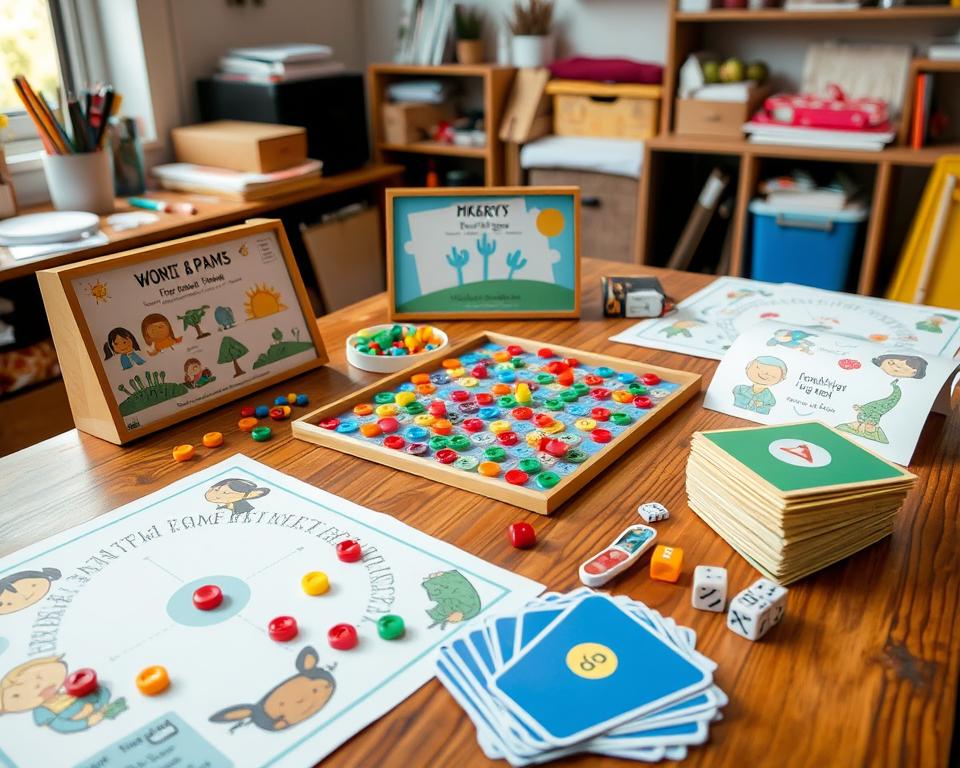
“Homemade board games are a fantastic way to make vocabulary practice fun and interactive for students of all ages.”
Sight Word Space Crusade: A Simple Yet Effective Game
Sight Word Space Crusade is a fun way to learn vocabulary. It’s a DIY board game that lets kids explore space while improving their sight-word skills. The game board is blank, making it easy to set up.
The game is easy to play but very effective. Kids roll a die and move their piece on the board. When they land on a sight word, they do a fun activity. This could be reading the word, building it with letters, or writing it in a sentence.
This game is great because it can be changed to fit different kids’ needs. Teachers can make it harder or easier, depending on the child. It’s perfect for reading centers or small groups.
“Sight Word Space Crusade is a game-changer in the world of DIY board games for kids. The game seamlessly blends hands-on learning with the excitement of space exploration, transforming vocabulary practice into an unparalleled experience.
If you’re a teacher or a parent, Sight Word Space Crusade is a great choice. It makes learning fun and exciting. Your kids will love exploring space and learning new words.

Monkey Maze Spelling Adventure
Discover the magic of DIY vocabulary board games with “Monkey Maze Spelling Adventure.” It’s a game that makes learning fun and exciting. It’s perfect for students of all ages.
The game adds excitement to weekly spelling practice. It features a blank game board with a monkey maze and a spelling word activity grid. Players can practice spelling or do fun activities from the grid.
This game is great for all skill levels. It lets everyone join in and do well.
“The Monkey Maze Spelling Adventure game has transformed our weekly spelling practice into a truly enjoyable experience for the entire class. The kids love the maze-like board and the chance to move around the game while reinforcing their spelling skills.”
The game combines a fun theme with learning vocabulary. It makes learning memorable and engaging. It shows how vocabulary board games diy and easy diy games for vocabulary can be powerful tools.
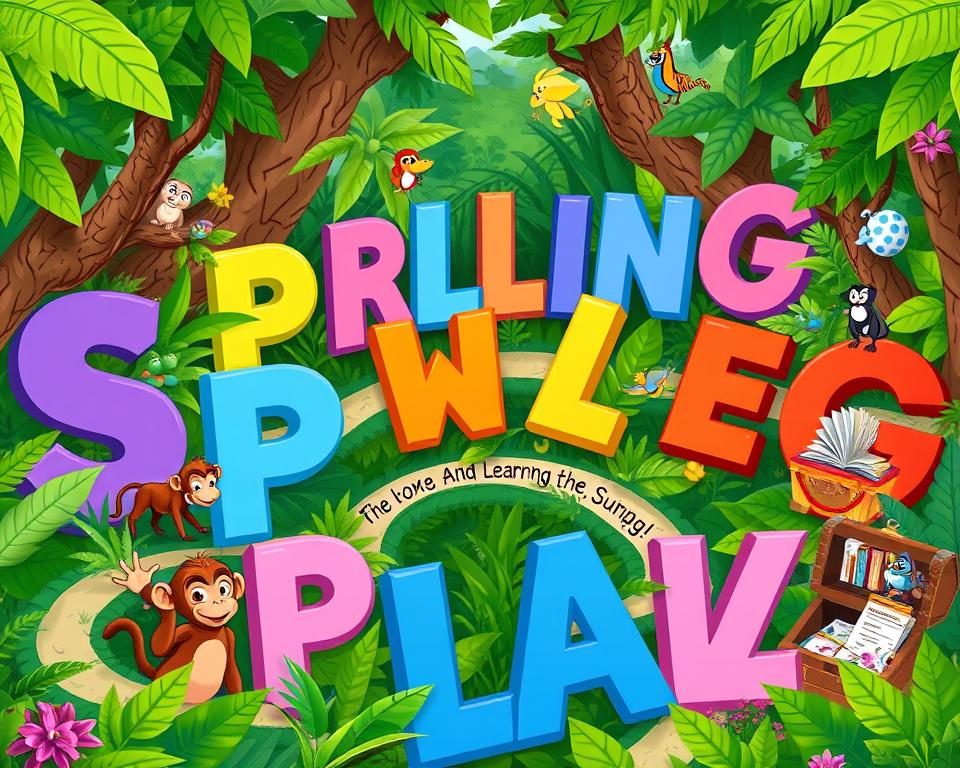
Teachers and parents will love this game. It’s perfect for making spelling lessons fun. Its design is simple yet effective, making it great for all.
Incorporating Theme-Based Learning Elements
Making DIY vocabulary games more fun is easy with theme-based learning. Themes that excite players can turn learning into an adventure. This makes the experience enjoyable rather than a task.
Choose themes that kids love, like battling aliens, surviving zombies, or helping Little Red Riding Hood. These stories can be part of the game, making learning feel like play. It’s less like homework.
“Motivation plays a critical role in language learning success. Motivated individuals tend to be more consistent in their practice and learn more compared to their less motivated peers,” explains Dr. Melissa Baese Berk.
Games with great themes really help kids learn and have fun. For example, Kloo helps with sentences, and Peaceable Kingdom Spanish Bingo teaches new words through play.
Adding themes to your games uses imagination and stories to make learning fun and memorable. Whether it’s fighting aliens or exploring a magical forest, the ideas are endless. Let your creativity shine.

The secret to great theme-based learning is finding the right mix of fun and learning. By designing the game’s story, rules, and words carefully, you create a fun and educational experience. This will keep players eager to play again.
Strategies for Different Learning Levels
Creating DIY vocabulary games is all about being flexible. These activities can be adjusted to fit various learning levels and styles. For younger students, start with simple tasks like reading sight words or spotting consonant blends. As they grow, the games can get more challenging, adding spelling tests, word meanings, and sentence usage.
DIY vocabulary games are great because they let everyone play together, no matter their skill level. By having different levels in one game, students can push themselves while working with their classmates. This creates a welcoming space where everyone can learn together.
“Vocabulary building activities that engage multiple senses and learning styles are essential for fostering word consciousness in young learners.”
To support different learning styles, mix up your teaching methods. Try games that involve movement, singing, reading aloud, and online lessons. This way, students with different preferences can find something that works for them.
Whether it’s simple sight word games or more complex vocabulary exercises, DIY board games are incredibly useful. They help with vocabulary building activities and hands-on learning resources in the classroom.

Tips for Making Games More Engaging and Durable
Creating fun and lasting vocabulary games for kids is key to learning. Get students involved in making the games. Add chance or competition to make it exciting. Use bright colors and cool graphics to grab their attention.
Games need to last a long time. Print boards on strong paper or laminate them. Use plastic sleeves for game cards. Think about making digital versions for updates and longer life. Change up the games often to keep things fresh and cover different skills.
- Engage students in the creative process of game design
- Use bright colors and appealing graphics to capture attention
- Incorporate elements of chance or competition for added excitement
- Print game boards on durable materials or laminate them
- Protect game cards with plastic sleeves
- Explore digital game versions for easy updates and longevity
- Regularly rotate games to sustain interest and address diverse skills
By following these tips, you can make vocabulary games that are fun and last. This will keep your students excited and help them improve their language skills.
“The best educational games are the ones that kids can’t wait to play.”
Remember, the secret to great vocabulary games is finding the right mix of fun and learning. With creativity and care, you can make games that will excite and inspire your students.

Common Design Mistakes to Avoid
When making your own vocabulary board games, avoid common mistakes. One big error is making the rules too hard. This can confuse and upset players. Keep it simple by focusing on one key skill or goal per game.
Another mistake is trying to pack too many skills into one game. Your goal is to offer focused practice, not a broad vocabulary lesson. Also, make sure your game board and pieces look good. Bad design can turn players off and make learning harder.
- Avoid overly complex rules that can confuse players
- Focus on one key learning objective per game
- Ensure the game’s visual design is clean and engaging
Don’t use generic names for your games. Use real, relevant words that match your learning goals. This makes the game more meaningful and helps players remember the words better.
Also, think about how hard your game should be. It should be challenging but not too hard for the players’ age. Playtesting your game can help you find and fix any problems.
“The best vocabulary games strike a perfect balance between fun and educational value.”
By avoiding these mistakes, you can make vocabulary board games that are fun and effective. With some effort, your DIY games can help people learn and grow.
DIY vocabulary board games are a fun, affordable way to learn new words. They let you tailor games to fit different ages and skill levels. A study by Marzano showed that these games can really help students learn.
With the help of this article, you can make games that are both fun and educational. You can create games for kids in grades 4 to 12 or for students up to 12th grade. This makes learning vocabulary exciting and engaging.
DIY games can be themed, adjusted for different learners, or made even better with new ideas. They make learning vocabulary a fun adventure. As kids play, they’ll learn new words and grow to love learning even more.
Ideas for DIY Vocabulary Board Games
1. Word Adventure Path
- Materials: Cardboard or poster board, markers, dice, small tokens (like coins or buttons).
- How to Play:
- Create a path with numbered spaces on a board.
- Write vocabulary challenges on certain spaces (e.g., “Spell a word starting with ‘S'” or “Define ‘persevere'”).
- Players roll the dice and move along the path, completing vocabulary tasks to advance.
- The first to reach the end wins.
2. Spin & Spell
- Materials: A spinner (can be made with cardboard and a brad), word cards, paper and markers.
- How to Play:
- Label spinner sections with tasks such as “Synonym,” “Antonym,” “Define,” and “Sentence.”
- Players spin the wheel and pick a card. They complete the corresponding task based on the word on the card.
- Award points for correct answers, and the player with the most points wins.
3. Vocabulary Bingo
- Materials: Bingo cards with vocabulary words, word definitions or images, markers or chips.
- How to Play:
- Create Bingo cards with vocabulary words in each square.
- Call out definitions, synonyms, or sentences with a missing word, and players cover the matching word on their cards.
- The first player to complete a row, column, or diagonal shouts “Bingo!” and wins.
4. Word Match-Up
- Materials: Index cards, markers.
- How to Play:
- Write words and their definitions, synonyms, or pictures on separate cards.
- Lay the cards face down in a grid.
- Players take turns flipping two cards, trying to match the word with its corresponding pair.
- The player with the most matches at the end of the game wins.
5. Build-a-Word
- Materials: Letter tiles (like Scrabble tiles or DIY cutouts), a simple game board.
- How to Play:
- Players move around the board collecting letter tiles.
- At specific spaces, they must form a word with their tiles.
- Bonus spaces can ask players to create longer words for extra points.
6. “Rainbow Race” DIY Game
- Theme: Colors.
- Objective: Learn color names and practice matching.
- Path Design: Draw a rainbow-shaped path with spaces in different colors.
- Rules: Roll a die to move. Land on a color space and name an object of that color.
- Game Pieces: Use small toys like animal figurines or cars as player markers.
Tips for Success
- Use Themes: Focus on topics like animals, food, or seasons to make the games more relatable.
- Incorporate Pictures: For younger learners or ESL students, include images to connect visual learning with words.
- Encourage Group Play: Board games work well for fostering social interaction and collaboration.
- Reward Effort: Use small prizes or certificates to motivate players.
DIY board games are an excellent way to transform vocabulary practice into an exciting activity. They promote learning through play, ensuring kids stay engaged and retain new words effortlessly.
Key Takeaways
- Homemade board games offer an engaging way to practice and reinforce vocabulary skills
- DIY board games can be easily created using simple materials and are suitable for various learning levels
- These games provide an interactive and fun approach to consolidating knowledge of key learning areas
- DIY board games are ideal for classroom use, reading centers, or home learning environments
- Incorporating vocabulary-building activities through hands-on learning resources can significantly boost student engagement and retention
Source Links
- DIY Board Games for the Classroom – https://www.teachstarter.com/us/blog/diy-board-games-for-the-classroom-3/
- DIY Board Games – https://literacyandlanguagecenter.com/diy-board-games/
- 5 Vocabulary Games That Build Content Knowledge – https://www.edutopia.org/article/vocabulary-games-content-knowledge/
- Magnetic Classroom Vocabulary Game – https://www.instructables.com/Magnetic-Classroom-Vocabulary-Game/
- Printable board game – create your own in 5 easy steps – https://www.theanimatedteacherblog.com/printable-board-game/?srsltid=AfmBOopx3KdibpkP2g6IueLc5HRUVLrl_eLg_upImQcXJQS01GHpryPs
- 9 Classroom Vocabulary Games to Use with Your Students – https://schools.magoosh.com/schools-blog/9-classroom-vocabulary-games-to-use-with-your-students
- How to create board games – https://www.slideshare.net/slideshow/how-to-create-board-games/19770786
- DIY Board Games: Crafting and Playing for Amusing Learning – LearningMole – https://learningmole.com/diy-board-games-educational-fun/
- Diy Board Games for Kids – https://www.pinterest.com/ideas/diy-board-games-for-kids/926325190611/
- 17 Best Vocabulary Games to Play in the Classroom and At Home – https://www.splashlearn.com/blog/best-vocabulary-games-for-kids/
- Crafty Classrooms: DIY Projects for Dynamic Learning – https://blog.joinwimzee.com/crafty-classrooms-diy-projects-for-dynamic-learning/
- PDF – https://rrnetwork.org/assets/general-files/LEP_Module3_FINAL.pdf
- 10 Best Game Room Decor Ideas To Beautify Your Gaming Room | Foyr – https://foyr.com/learn/best-game-room-decor-ideas
- The Reading Skill Set Part 1: Sounds to Reading & Phonics | Lovevery – https://lovevery.com/products/part-1-sounds-to-reading?srsltid=AfmBOor4PqdUrf-QEG2Ni5YPI3zwjNNISsxyYoPHTBX1lIULYRe6Ixvc
- KinderTown Blog | Educational App Reviews, Activites, and More! – https://kindertown.com/blog/page/9/
- Math Games for Exploring Patterns and Relationships – https://dudutoys.sg/blogs/articles/math-games-for-exploring-patterns-and-relationships?srsltid=AfmBOoqC3i5bVYh71cqzje5g3qA3gEodP3CABZgksnOa1uYXxv3N5yM4
- 16 Language Learning Games & Activities: Fun & Effective – https://preply.com/en/blog/at-home-language-learning-games/
- Educational Benefits of Board Games – https://julianbennett8.medium.com/educational-benefits-of-board-games-7d7316d30094?source=rss——-1
- Top 12 Board Games for Your ESL Classroom – https://busyteacher.org/7756-top-12-board-games-for-the-esl-classroom.html
- Games & activities for different learning styles – fun ideas for kids – https://www.novakidschool.com/blog/games-activities-for-different-learning-styles-fun-ideas-for-kids/
- Vocabulary Activities and Games for Kids – https://andreaknightteacherauthor.com/vocabulary-activities-and-games-for-kids/
- Why board games for teaching are an amazing asset for your lessons – The ESL Educator – https://theesleducator.com/games-for-teaching/
- Fun Spelling and Vocabulary Activities – Silo & Sage – https://siloandsage.com/2022/10/19/fun-spelling-and-vocabulary-activities/
- Sweet Softies: How to Improve Your Word Game Skills for More Enjoyable Family Time – https://www.sweetsofties.com/2024/04/improving-your-word-game-skills.html
- Context Clues – The Gaming Grammarian – https://thegaminggrammarian.com/tag/context-clues/
- 10 Classroom Vocabulary Games For All Ages | Sadlier School – https://www.sadlier.com/school/vocabulary-games
- Creative & Easy Games and Activities to use with Flashcards! – http://hashtagteachermom.blogspot.com/2013/10/number-games-activities-to-use-with.html

